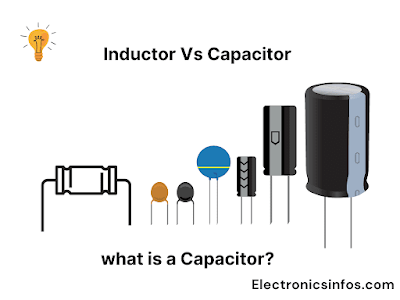Comparison Between Inductor and Capacitor
What is an Inductor?
An inductor is an electrical component that stores energy in a magnetic field. It is a coil of wire wound around a core made of a magnetic material. A magnetic field is generated and stored when a current flows through the coil. The basic principle behind an inductor is Faraday's law of electromagnetic induction
Inductor
- An inductor is a passive component that stores energy in a magnetic field when current flows through it.
- The symbol for an inductor is a coil or a series of loops.
- Inductors have higher impedance (reactance) to high-frequency signals and lower impedance to low-frequency signals
- Inductors resist changes in current and do not allow direct current (DC) to pass through easily.
- An inductor is typically made of a coil of wire wound around a core made of magnetic material, such as iron or ferrite.
- inductors are characterized by their inductance, which measures their ability to store energy in a magnetic field. Inductance is measured in units called henries (H).
- In filter circuits, inductors block certain frequencies and allow only desired frequencies to pass.
- Inductors store energy in applications such as transformers and magnetic ballasts.
- Inductive loads, such as motors and solenoids, use inductors to convert electrical energy into mechanical energy.
- Inductors are used in oscillator circuits to generate continuous oscillations.
- Inductors tend to resist changes in current, making them suitable for applications involving time delays or filtering low-frequency signals.
- Inductors have energy dissipation due to resistive losses in the coil winding.
- Inductors store energy in the form of current. The higher the current flowing through an inductor, the higher the energy stored.
- Inductors are commonly used in applications such as filtering, energy storage, transformers, and inductive loads.
- The time constant of an inductor depends on the inductance value and the resistance in the circuit.
- Inductors add in series and reduce in parallel.
- Inductors do not have voltage polarity.
- The impedance of an inductor increases with frequency (inductive reactance = 2πfL) and decreases with resistance.
- Inductors cause phase delays in current concerning voltage in AC circuits.
- When power is removed from an inductor, it releases the stored energy back into the circuit.
- Inductors resist changes in current and exhibit slower transient responses.
- Inductors pass low-frequency signals and attenuate high-frequency signals.
- The impedance of an inductor increases with frequency, making it more effective at higher frequencies.
what is a Capacitor?
A capacitor is an electronic component that stores electrical energy in an electric field. It consists of two conductive plates separated by an insulating material called a dielectric. When a voltage difference is applied across the plates, an electric field is formed between them, and the capacitor stores energy in this field.
Capacitor
- A capacitor is a passive component that stores and releases electrical energy in an electric field. It opposes changes in voltage and allows AC signals to pass while blocking DC.
- Capacitors block DC voltage and act as open circuits.
- the symbol for a capacitor is two parallel plates.
- A capacitor consists of two conductive plates separated by an insulating material called a dielectric. The dielectric can be air, ceramic, plastic, or electrolytic material.
- Capacitors are characterized by their capacitance ability to store charge.
- Capacitance is measured in units called farads (F).
- Capacitors have lower impedance to high-frequency signals and higher impedance to low-frequency signals.
- Capacitors exhibit reactance, which is their opposition to the change in voltage for the frequency of the applied signal. The reactance of a capacitor decreases with increasing frequency.
- Capacitors tend to resist changes in voltage, making them suitable for applications involving time delays or filtering high-frequency signals.
- Capacitors store energy in applications such as power supply filtering and energy storage systems.
- Capacitors are used for coupling signals between stages of an electronic circuit.
- Capacitors are used in timing circuits and oscillators to control the timing of events.
- Capacitors have energy dissipation due to resistive losses in the dielectric material.
- Capacitors are used in filter circuits to pass certain frequencies and block others.
- Capacitors are used in motor starter circuits to provide an initial boost of current for starting electric motors.
- Capacitors are used in energy storage, filtering, decoupling, timing, and coupling.
- The time constant of a capacitor depends on the capacitance value and the resistance in the circuit.
- Capacitors are reduced in series and added in parallel.
- Capacitors have voltage polarity, with one terminal being positive and the other being negative.




-Electronicsinfos.png)



0 Comments
please do not insert spam links